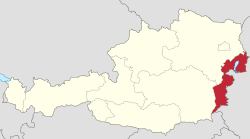Republic of Heinzenland
Republic of Heinzenland Republik Heinzenland Republik Hoanznlaund (local dialect) Hiénc Köztársaság | |||||||||||
|---|---|---|---|---|---|---|---|---|---|---|---|
| 1918–1918 | |||||||||||
 | |||||||||||
| Status | Unrecognized state | ||||||||||
| Capital | Mattersburg | ||||||||||
| Government | Republic | ||||||||||
| Historical era | World War I | ||||||||||
• Established | December 5, 1918 | ||||||||||
• Disestablished | December 7, 1918 | ||||||||||
| |||||||||||
The Republic of Heinzenland (
Etymology
The name "Heinzenland" is derived from the German name for Western Hungary, Heanzenland, Hianzenland, or Hoanzenland[1] (Heinzenland in Standard German).[2] The name "Heanzen" or any variation of it in local dialects referred to German settlers in Western Hungary (west of Sopron), who immigrated from Bavaria and other parts of Germany to Hungary while keeping their own dialects (hence the variation between the names).[3]
There are different theories as to why the Heinzen was used. It may have been used to mock this group of German-speakers for their deviation from the Bavarian hiaz (now), instead using hianz. It might also have been derived from the common name Heinz, or from the followers of Henry II, Duke of Bavaria, Henry I Kőszegi, or Henry IV, Holy Roman Emperor, under whose reigns the settlers came.[4]
Background
The formation of the
Soon after, Austrians working for the Austrian government began to distribute propaganda in the region. The first to protest against Hungarian rule were the locals of Mattersburg, who were against the teaching of Hungarian in schools. On November 17, locals from Bad Sauerbrunn and Pöttsching declared their desire for annexation by Austria. Weapons shipments started in December - On December 5, a truck carrying 300 rifles from Wiener Neustadt bound towards Burgenland was intercepted by the Hungarian police at Neufeld an der Leitha. Another shipment on the same day, also of 300 guns, successfully reached its destination of Mattersburg. Rifles were distributed among the locals, who prepared to take the town and its environs.[5]: 20–1
The Two-Day Republic
On December 5, 1918[7] (some sources claim the Republic was actually proclaimed on December 6),[8][5]: 21 two weeks after the Staatsrat demanded the self-determination of German-speaking settlements in Western Hungary, Social Democratic politician Hans Suchard, with the help of workers and local Social Democrats in Mattersburg, proclaimed the Republic of Heinzenland. This was done, apparently, without sufficient knowledge of power relations in the region. The Republic was formed with the intention of preparing the annexation of the region by Austria.[9]
However, one day later, an armored train and a machine gun squad sent by the Hungarian military, helped by vigilantes from Sopron, put an end to the Republic, quickly occupying its territory without bloodshed. When interrogated, the rebels claimed they had been connected to the Austrian government. However, the Austrian government denied any association with the Republic - they sought to avoid any conflict with Hungary.[5]: 21
References
- ISBN 978-3-205-78193-6
- ^ Das Heinzenland. In: Oststeirerblatt. Wochenschrift zur Wahrung der wirtschaftlichen Interessen der Oststeiermark und Deutsch-Westungarns I, Nr. 8 (2. November 1919), S. 1 nach Wolfram Dornik, „Das war wie im Wilden Westen“, S. 74
- ^ "Das Heanzenland. 3sat, Reihe Stadtland". 3sat.de. Retrieved 11 November 2019.Hans Ferdinand Helmolt: Weltgeschichte. Band Südosteuropa und Osteuropa. (= Band 5 Weltgeschichte), Bibliographisches Institut, Leipzig 1905, S. 390
- ISBN 978-3-89994-124-1, S. 68.
- ^ a b c d Székely, T. (2021). The Agony of Historic Western Hungary and the Birth of Burgenland (1914-1921). Studies on National Movements (SNM), 6, 38. Retrieved from https://test.snm.nise.eu/index.php/studies/article/view/70
- ^ Ferenc, Szávai. "A Hiénc Köztársaság (1918. December 6–7.)." Ünnepi tanulmányok Oroszi Sándor 70. születésnapja tiszteletére.
- ^ Hans Suchard (21 November 1929). "Eine Republik, die 12 Stunden alt wurde".
- ^ Österreich in Geschichte und Literatur mit Geographie. Institut für Österreichkunde. 1982.
- ISBN 3702803114.
Further reading
- August Ernst: Geschichte des Burgenlandes, R. Oldenbourg Verlag München, 1991. ISBN 3702803114.
- Gerald Schlag: Aus Trümmern geboren – Burgenland 1918–1921 (= Wissenschaftliche Arbeiten aus dem Burgenland. Band 106). Burgenländisches Landesmuseum, Eisenstadt 2001, ISBN 3-85405-144-1, Seite 136ff. (Online)
